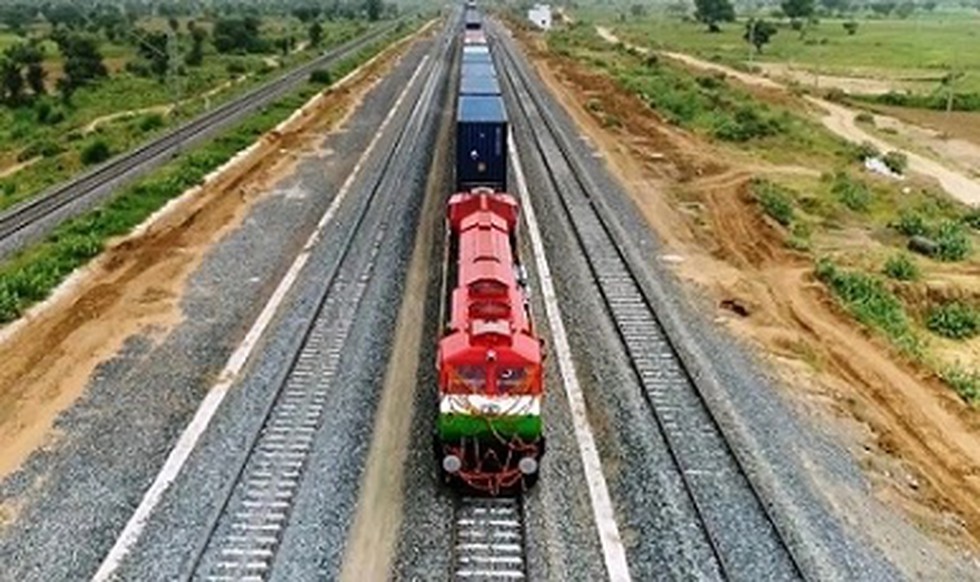
Indian Railways’ DFC : 18-year mission on track
NEW DELHI : Maruti Suzuki’s automotive parts travel the 659 km between New Rewari in Haryana to Palanpur in Gujarat on the truck-on-train service (ToT) provided by the Dedicated Freight Corridor Corporation of India Ltd (DFCCIL), in 12-odd hours — about half the time it takes by road.
Vinsum Axpress, a logistics company, which handles the consignment, shifted to the ToT service in February, using 6-8 wagons. “We are more than willing to expand operations along the dedicated freight corridor. Our initial experience in transporting automotive parts has been very good,” says Vinod Sharma, Chairman and MD, Vinsum Axpress.
Eighteen-odd years after it was first proposed, over 90 per cent of the 2,843 km of railway corridors dedicated to freight transport — built at a cost of ₹1.24-lakh crore — is operational.
DFCCIL, a special purpose vehicle of Indian Railways, operates both arms of the corridor — the 1,337-km Eastern Dedicated Freight Corridor (EDFC) from Ludhiana in Punjab to Sonnagar in Bihar, which is fully operational; and the 1,506-km Western Dedicated Freight Corridor (WDFC) from Jawaharlal Nehru Port Terminal in Navi Mumbai, Maharashtra, to Dadri in Uttar Pradesh, of which 88 per cent (around 1,300 km) is operational.
And with nearly 140 km more being commissioned and ready for operations by April-end, post inspection, over 96 per cent of the network will be completed, making it a significant milestone in India’s freight movement history.
Dedicated freight corridor looks to ramp-up truck-on-train services
The first train on the dedicated freight corridor was flagged off by Prime Minister Narendra Modi in December 2020, between New Bhaupur and New Khurja in Uttar Pradesh. More than 1.7 lakh trains have since traversed the dedicated freight corridors.
The 110-km connectivity between JNPT and Vaitarna in Maharashtra, on the WDFC, is expected to be completed within a year.
Cost saving
Vinsum’s Sharma says the freight corridor saves the company nearly ₹12,000 per truck per trip, which it would otherwise pay as road toll on the Haryana–Ahmedabad route, not to mention the savings on time and fuel.
“My overall cost savings, after switching to the rail network, is nearly 50 per cent,” he says.
The ToT service began in February with transporting milk and other perishables between Gujarat and Uttar Pradesh before adding non-perishables, including automotive parts and cement.
There are plans to add even more items, given the cost savings. For instance, the transport cost per kg per km on roadways is ₹4 (on average across categories), while through railway it is ₹1.36 for foodgrains, ₹2.47 for iron ore, and ₹2.13 for petroleum products.
DFCCIL is in talks with e-commerce players like Amazon, Flipkart and Meesho for the use of WDFC for their transport needs, especially leveraging the corridor’s proposed connectivity to JNPT port.
“Talks are also on with other logistics players who rely on e-commerce orders,” says an official, who declines to be named.
Interestingly, Amazon is already piloting the use of the Rewari–Palanpur section of the dedicated freight corridor for the movement of goods along the Haryana–Gujarat industrial corridor. A single coach with 18-tonne capacity is being run daily for the e-commerce major.
Optimal operation
Against the dedicated freight corridor’s optimum capacity of 480 trains per day on both arms together, there are 300-320 running currently (200 on EDFC and 100 on WDFC); the average speed is 55-60 km per hr (maximum is 100 kmph), compared with 20 kmph on the Indian Railways freight service.
“The idea is to bring down logistics costs with faster movement of freight trains, as compared to road movement. The corridor is already running at 63-odd per cent capacity and the time saved is around 40 per cent,” a senior DFCCIL official says.
According to an environmental assessment by E&Y, the dedicated freight corridor can cut carbon dioxide emissions by around 457 million tonnes over the next 30 years.
The halts along the corridor are spaced at around 40 km, against 5 km on other tracks, leading to faster movement of goods.
The organisation also uses modified general sleeper (NMGS) wagons — that is, coaches that were previously used in older passenger trains and phased out over the last few years are being modified to run parcel services.
